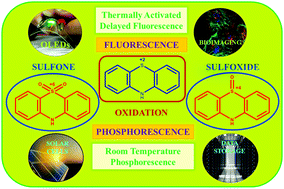Recent development on the synthesis, properties and applications of luminescent oxidized phenothiazine derivatives
Abstract
Oxidized phenothiazine chromophores have received significant attention in various technological applications including organic light-emitting diodes (OLEDs), photovoltaic devices, data storage, sensors and bioimaging due to their excellent photoluminescence properties, low toxicity, easy synthetic modification, non-planar structure and environmentally friendly behavior. The oxidized phenothiazine chromophores exhibit high phosphorescence quantum yields, better photochemical and photothermal stabilities, and long-lived emission lifetimes in the solid state. The oxidized phenothiazine derivatives possess room temperature phosphorescence properties which enhance the importance of phenothiazine 5-oxide and phenothiazine 5,5-dioxide units and provide a new pathway for their multi-purpose applications like digital security, optical recording devices, bioimaging, sensors, organic light-emitting diodes, data storage, low-cost anti-counterfeiting technologies and temperature monitoring. In this review, we have explained the synthesis, photophysical, photoluminescence, electrochemical, theoretical and room temperature phosphorescence properties of phenothiazine 5-oxide and phenothiazine 5,5-dioxide derivatives. In the current situation, the outlook of this review provides a better understanding of the significance of phenothiazine 5-oxide and phenothiazine 5,5-dioxide units for the development of novel materials for optoelectronic and biological applications.

- This article is part of the themed collection: Showcasing recent research in materials chemistry from IIT Bombay, IIT Indore and IISc


 Please wait while we load your content...
Please wait while we load your content...